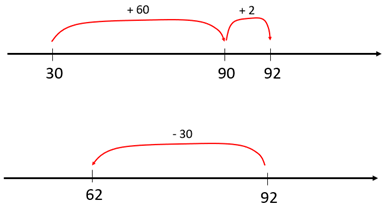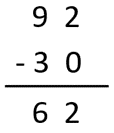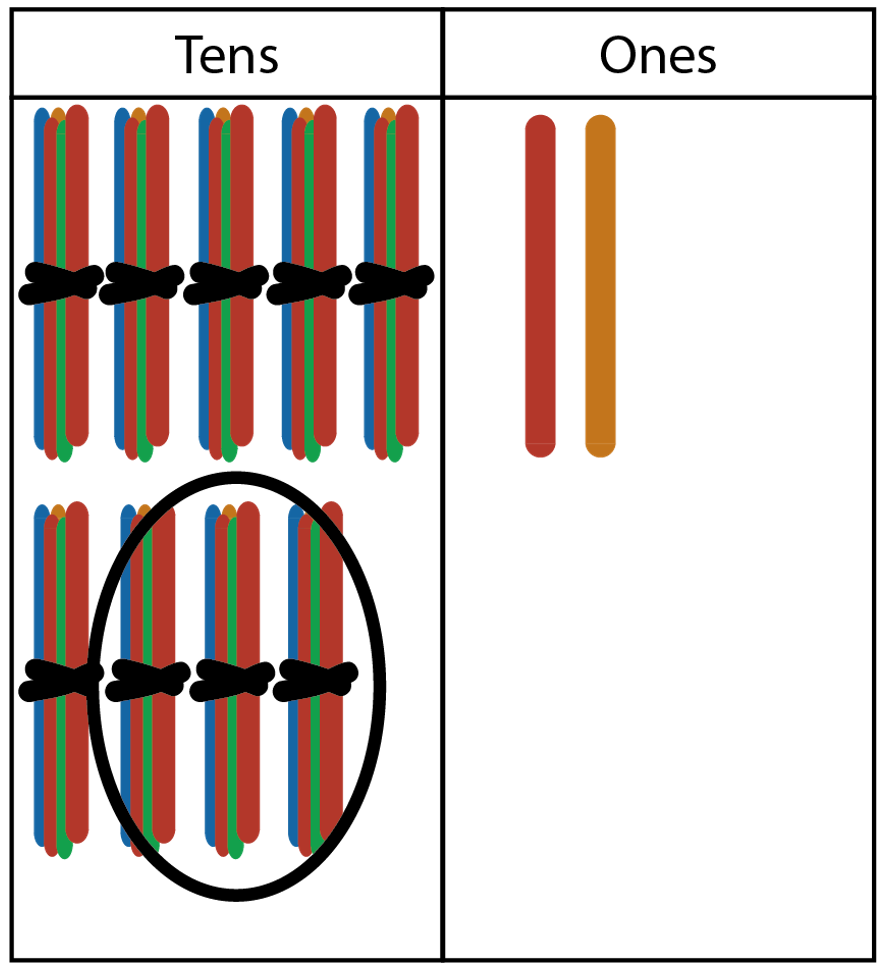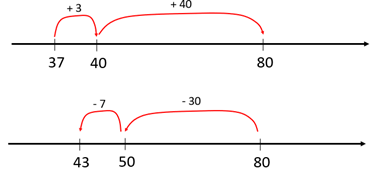The purpose of this activity is to support students using their knowledge of place value to solve difference problems with two-digit numbers, without renaming ten as ten ones.
- Place value materials: individual items grouped into tens, such as BeaNZ in film canisters, iceblock sticks bundled with rubber bands (hundreds with hair ties), or a paper form such as Place Value People. Bundled materials are important as they allow partitioning and combining without the need for “trading” tens blocks for ones.
- A place value board is used to organise materials into columns and support calculation strategies. Three-column and four-column place value boards are available here.
 Pose difference problems with two-digit numbers in which the smaller amount is a multiple of ten, such as 20, 30, or 40. Make the quantities using bundles of materials and arrange them vertically on a place value board.
Pose difference problems with two-digit numbers in which the smaller amount is a multiple of ten, such as 20, 30, or 40. Make the quantities using bundles of materials and arrange them vertically on a place value board.
- Mask the model using a sheet of paper. For example:
You have 45 ice block sticks and I have 20 ice block sticks.
How many more ice block sticks do you have than I have?
Using a place value board, place 4 bundles of 10 sticks in the tens column and 5 individual sticks in the ones column.
- Ask students to work out the difference, using whatever strategy they prefer. They are likely to use either addition or subtraction. Discuss each strategy, its efficiency in relation to the problem, and the changes made to the numbers involved.
- Adding on from 20 to get to 45. This strategy can be represented by an empty number line.

- Subtracting 20 from 45. This strategy can also be represented on an empty number line or as a vertical algorithm. Note that the latter representation might demonstrate procedural knowledge, rather than an understanding of place value.


- Pose other problems in which the smaller amount is a multiple of ten and in which the difference is extended. Encourage use of number facts and place value.
You have 92 ice block sticks and I have 30 ice block sticks.
How many more ice block sticks do you have than I have?
If needed, support students' recognition of place value by making the quantities with bundles of materials and arranging them vertically on a place value board. Gradually mask the materials to support greater reliance on symbolic recording and mental or written strategies.
- As before, discuss the strategies used (i.e. addition or subtraction), how the digits change or stay the same (and why), and the efficiency of each strategy in relation to each problem.

- Note that subtraction is only more efficient in this example if the calculation, 92 – 30 = 62, is completed in one step. Some students use several steps to do this; “First I take off the 2 to get 90, then I take off 30, that’s 60. Then I put the 2 back on to get 62.”
- A vertical algorithm, supported by a bundled-materials model, might encourage students to recognize that only the tens digit changes.


- Provide examples in which the larger number is a multiple of ten.
You have 80 ice block sticks and I have 37 ice block sticks.
How many more ice block sticks do you have than I have?
What calculation or strategy might you use? Why?
If needed, set up a physical model and mask it.
Record the possible strategies symbolically: 37 + [ ] = 80 and 80 - 37 = [ ].
- Invite students to answer the problem and discuss the most efficient strategy. Use empty number lines to record their strategies.

In this case the strategies are equally efficient though adding on is probably easier to do mentally.
- Provide time for students to work on further, similar examples in appropriate groupings (e.g. pairs, those that encourage tuakana-teina, working with the teacher). For example:
- You have 60 ice block sticks and I have 14 ice block sticks.
How many more ice block sticks do you have than I have? - You have 90 ice block sticks and I have 79 ice block sticks.
How many more ice block sticks do you have than I have?
- You have 60 ice block sticks and I have 14 ice block sticks.
Ensure students have opportunities to express their mathematical thinking in different ways (e.g. online tasks, written, verbal, drawn diagrams, acting out, using physical manipulatives).
- After students have answered the questions, gather together and discuss the strategies used and their efficiency. This might be done by using post-it notes, a digital whiteboard, or by having students raise their hands to indicate whether they used addition or subtraction.
How does the size of the numbers change the efficiency of a strategy?
Students might notice that when the numbers are close to each other, adding on is usually more efficient. For example, 79 + 11 = 90 so the difference between 90 and 79 is 11.
When the smaller number is a multiple of ten then subtraction is usually easier, especially if the numbers are not close. For example, 93 – 20 = 73 so the difference between 93 and 20 is 73.
Next steps
Increase the level of abstraction to the point where students can work with symbols without the need for physical models. Develop fluency with strategies like ‘back through a decade’ and ‘up through a decade’ by practising problems like 65 - 8 = [ ] and 47 + 9 = [ ] .
A suggested sequence for extending the difficulty of finding differences is:
- Use smaller multiples of ten, such as the difference between 52 and 20.
- Use larger multiples of ten, such as the difference between 96 and 70.
- Use numbers where the difference is greater, such as the difference between 83 and 20.
- Use numbers where the greater is a multiple of ten, such as the difference between 47 and 70.
- Extend the size difference for the numbers in d, such as the difference between 14 and 90.